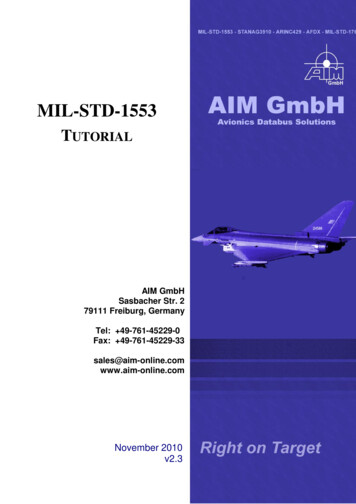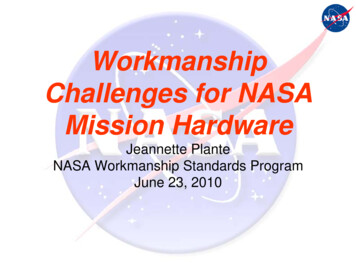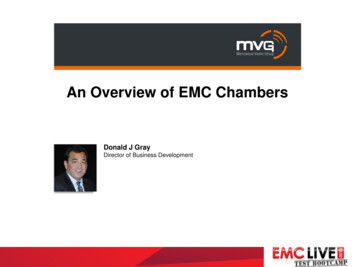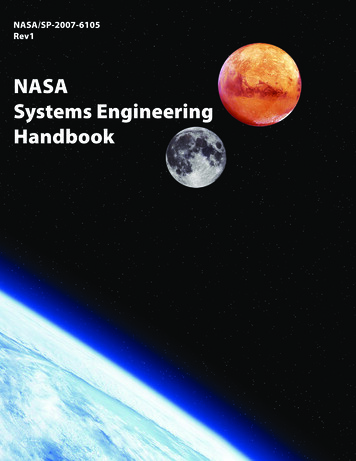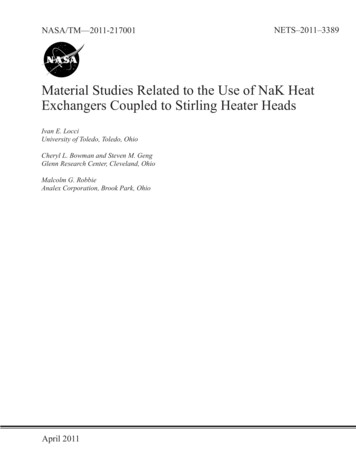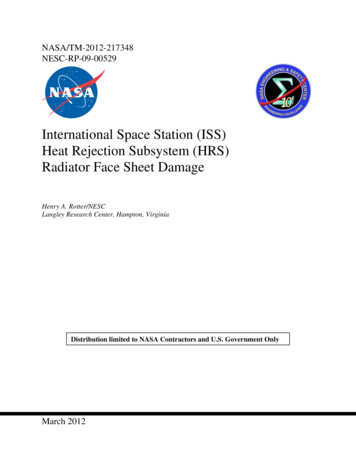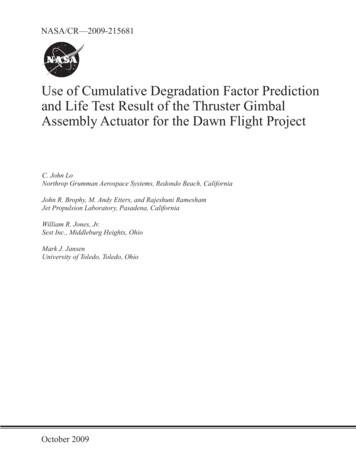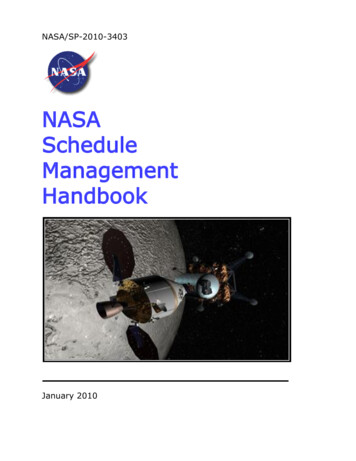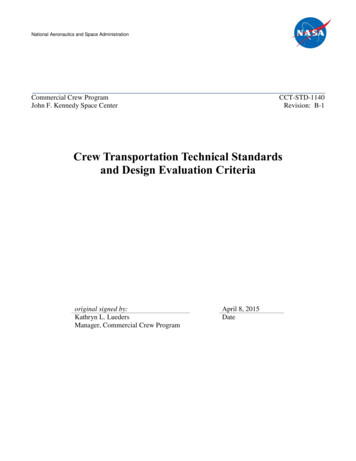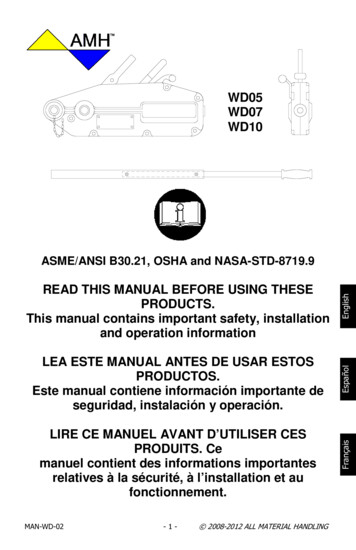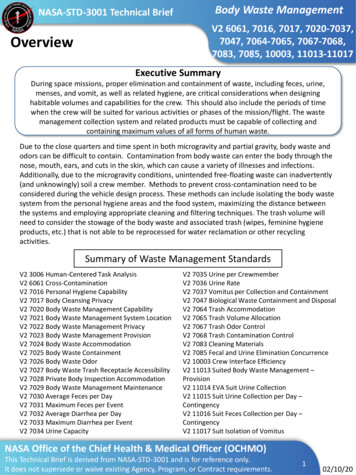
Transcription
NASA-STD-3001 Technical BriefBody Waste ManagementV2 6061, 7016, 7017, 7020-7037,7047, 7064-7065, 7067-7068,7083, 7085, 10003, 11013-11017OverviewExecutive SummaryDuring space missions, proper elimination and containment of waste, including feces, urine,menses, and vomit, as well as related hygiene, are critical considerations when designinghabitable volumes and capabilities for the crew. This should also include the periods of timewhen the crew will be suited for various activities or phases of the mission/flight. The wastemanagement collection system and related products must be capable of collecting andcontaining maximum values of all forms of human waste.Due to the close quarters and time spent in both microgravity and partial gravity, body waste andodors can be difficult to contain. Contamination from body waste can enter the body through thenose, mouth, ears, and cuts in the skin, which can cause a variety of illnesses and infections.Additionally, due to the microgravity conditions, unintended free-floating waste can inadvertently(and unknowingly) soil a crew member. Methods to prevent cross-contamination need to beconsidered during the vehicle design process. These methods can include isolating the body wastesystem from the personal hygiene areas and the food system, maximizing the distance betweenthe systems and employing appropriate cleaning and filtering techniques. The trash volume willneed to consider the stowage of the body waste and associated trash (wipes, feminine hygieneproducts, etc.) that is not able to be reprocessed for water reclamation or other recyclingactivities.Summary of Waste Management StandardsV2 3006 Human-Centered Task AnalysisV2 6061 Cross-ContaminationV2 7016 Personal Hygiene CapabilityV2 7017 Body Cleansing PrivacyV2 7020 Body Waste Management CapabilityV2 7021 Body Waste Management System LocationV2 7022 Body Waste Management PrivacyV2 7023 Body Waste Management ProvisionV2 7024 Body Waste AccommodationV2 7025 Body Waste ContainmentV2 7026 Body Waste OdorV2 7027 Body Waste Trash Receptacle AccessibilityV2 7028 Private Body Inspection AccommodationV2 7029 Body Waste Management MaintenanceV2 7030 Average Feces per DayV2 7031 Maximum Feces per EventV2 7032 Average Diarrhea per DayV2 7033 Maximum Diarrhea per EventV2 7034 Urine CapacityV2 7035 Urine per CrewmemberV2 7036 Urine RateV2 7037 Vomitus per Collection and ContainmentV2 7047 Biological Waste Containment and DisposalV2 7064 Trash AccommodationV2 7065 Trash Volume AllocationV2 7067 Trash Odor ControlV2 7068 Trash Contamination ControlV2 7083 Cleaning MaterialsV2 7085 Fecal and Urine Elimination ConcurrenceV2 10003 Crew Interface EfficiencyV2 11013 Suited Body Waste Management –ProvisionV2 11014 EVA Suit Urine CollectionV2 11015 Suit Urine Collection per Day –ContingencyV2 11016 Suit Feces Collection per Day –ContingencyV2 11017 Suit Isolation of VomitusNASA Office of the Chief Health & Medical Officer (OCHMO)This Technical Brief is derived from NASA-STD-3001 and is for reference only.It does not supersede or waive existing Agency, Program, or Contract requirements.102/10/20
NASA-STD-3001 Technical BriefOverviewBody Waste ManagementV2 6061, 7016, 7017, 7020-7037,7047, 7064-7065, 7067-7068,7083, 7085, 10003, 11013-11017Previous concerns from crew include: Odor control is important and will affect a crewmember’s appetite due to the strong smellsfollowing a bowel movement. Contamination from the Waste Management System (WMS) is difficult to mitigate when the foodsystem is only 1-foot away. Maximum Absorbency Garments (MAGs) should not be required to be worn consecutively forlong durations due to skin irritations. Defecation could take 45 minutes in microgravity. The fecal bag “doesn’t stick to your butt well”, so escapees happen and was described as “acomplete mess.” The Urine Collection Device (UCD) was uncomfortable and frequently leaked. There was someirritation when used. The backpressure of the urine bag contributed to in-flight UTIs. Crew was very concerned about voiding ability during time-critical OPS the amount of time it tookto get set-up for a voiding dump.Risks from Body Waste and Hygiene ContaminationIn-mission risk Cross contamination with fecal mater and other human waste is a known risk to humanhealth to cause medical events that can be deleterious to the crews health andproductivity (see medical event below). Due to limitations of resources available and distance from Earth, treatment ofunexpected medical events can lead loss of mission.Possible medical events associated with contamination from body waste or use of body waste system Gastrointestinal Distress (including gas, bloating, diarrhea, abdominal pain) Urinary Tract Infections (UTIs) Skin rashes Infection Eye IrritationMission DurationShorter missions generally require less extensive personal hygiene facilities. Additional guidelines fordetermining facility needs are discussed in the section, Architectural Considerations of the HIDH. Forsafety and health reasons, hygiene facilities must be designed to accommodate partial-body or fullbody cleansing before and/or after these functions: Urination and defecation Exercise Medical activities Experimentation or other work requiring specialized washing Meal consumption Accidental exposure to toxic substances Eye contaminationNASA Office of the Chief Health & Medical Officer (OCHMO)This Technical Brief is derived from NASA-STD-3001 and is for reference only.It does not supersede or waive existing Agency, Program, or Contract requirements.202/10/20
NASA-STD-3001 Technical BriefReference InformationBody Waste ManagementV2 6061, 7016, 7017, 7020-7037,7047, 7064-7065, 7067-7068,7083, 7085, 10003, 11013-11017Feces: Fecal mass values are for the biological materialonly. Fecal collection and containment includes both thebiological material and all hygiene productsrequired for immediate body cleaning afterdefecation, but mass/volume quantities are limitedto the body output only The body will generate the same quantity of fecalmaterial based on the food consumption and anindividual’s metabolism. The variables are theevacuation frequency and water content. The collection capacity requirements account forthe average healthy adult stool output/day (150g/defecation at a rate of twice per day). Thenumber of defecations per day is individuallyvariable ranging from 2/week to 5/day, with theassumed average of 2/day.Diarrhea: Diarrheal events are assumed to be in place ofnormal fecal elimination with the increasedquantity based on increased water content andminor amounts of intestinal cellular material. The 1.5 L of diarrhea is based on most likelymaximal discharge in afflicted individuals. Acrewmember could experience up to 8 diarrheaevents (average volume of 0.5 L each) per day forup to 2 days, which must be accommodated.Note: Waste collection should accommodate allvariations of stool, however “normal” feces istypically types 3-4.An artificial gravity study at the University of TexasMedical Branch and a Tufts University bed reststudy studied the fecal weights of 32 subjects whoconsumed meals with a nutritional equivalent tothat of current spaceflight meals. These studiesresulted in an average of 137.69 grams/eventwith a maximum event of 504.21 grams.(Smith etal.)References Apollo Medical SummitApollo Flight Journal. https://history.nasa.gov/afj/Apollo Program Summary Report. an Integration Design Handbook, Revision 1. Section 7.4 Body Waste Management.Quantification of menstrual blood loss. The Menorrhagia Research Group. The Obstetrician & Gynaecologist. 6:8892, 2004.Smith, Scott M., principal investigator, 2006, Artificial Gravity Study, University of Texas Medical BranchNASA Office of the Chief Health & Medical Officer (OCHMO)This Technical Brief is derived from NASA-STD-3001 and is for reference only.It does not supersede or waive existing Agency, Program, or Contract requirements.302/10/20
Body Waste ManagementNASA-STD-3001 Technical BriefV2 6061, 7016, 7017, 7020-7037,7047, 7064-7065, 7067-7068,7083, 7085, 10003, 11013-11017Reference InformationUrine: The waste management system must becapable of collecting and containing a maximum totalurine output volume of: Vu 3 2t liters percrewmember, where t is the mission length in days.Urine production on the first day after launch is 3 litersper crewmember. Urine output may be slightly greateror less in different phases of the mission (associatedwith g-transitions) and with different fluid intake levels.The average void will vary from 100 to 500 mL. Rarely,a single void might be as much as 1 liter, so theequipment must be able to accommodate thismaximum.The capability must exist to collect 1 liter of urine percrewmember per hour. The rate of urinary delivery intothe system from the body will vary by gender (greaterfor females because of lower urethral resistance) butaverages 10 to 35 mL/s. Maximum flow rate withabdominal straining in a female may be as high as 50mL/s for a few seconds, and must be accommodated.The number of urinations per day is individuallyvariable, with an average of six times per day, whichmust be accommodated.Anatomical Measurements for BodyWaste Management DesignAnatomyDescriptionDimension Range(cm)MaleFemaleALateral separation of ischial tuberosity10-1411-16BWidth of perineal furrow7.5-97.5-9CAnterior and posterior separation betweentuberosities and exterior urethral opening13-276-9DAnterior and posterior separation betweenanus and external urethral opening15-30.59-11.5Note: Urine output may be slightly greater or lessin different phases of the mission (associated withg-transitions) and with different fluid intake levels.Vomitus: Space Adaptation Syndrome (SAS) occurs in up to 70% of first time fliers (30% of whom mayexperience vomiting) during the first 48 to 72 hours of microgravity. In addition, a possible water landingmay cause crewmembers to succumb to sea sickness. The average number of vomiting episodes percrewmember will vary from 1 to 6 per day, over a 2- to 3-day period.The waste management system must be capable of collecting and containing vomitus for up to 8 eventsof an average of 500 mL each. The maximum volume of expelled vomitus can be 1 L of solids and fluids,with a fully distended stomach. The average volume of vomitus is more likely to be 200 to 500 mL.NASA Office of the Chief Health & Medical Officer (OCHMO)This Technical Brief is derived from NASA-STD-3001 and is for reference only.It does not supersede or waive existing Agency, Program, or Contract requirements.402/10/20
NASA-STD-3001 Technical BriefReference InformationBody Waste ManagementV2 6061, 7016, 7017, 7020-7037,7047, 7064-7065, 7067-7068,7083, 7085, 10003, 11013-11017Menses: Approximately once every 26 to 34 days and lasting 4 to 6 days,approximately 80% released during first 3 days. The capability must existto collect and contain 113.4 grams per female crewmember per cycle.ISS Waste ManagementSystemThe Menorrhagia Research Group 2004Summary of Waste StandardsWasteTypeFecesaAverage Per EventMaximum Per EventDuration/FrequencyVolume: 150 mL (5 fl. oz.)Mass: 150 g (0.13 lb)Average of two eventsper dayDiarrheabVolume: 500 mL (16.9 fl. oz.)Mass: 500 gVolume: 100-500 mL (3.4-16.9 fl. oz.)Flow Rate: 10-35 mL/s (0.34-1.2 fl. oz./s)Mass: 100.7-513.8 g (0.2-1.1 lb)Volume: 500 mL (16.9 fl. oz.)Mass: 500 g (1.1 lb)Length: 33.0 cm (13.0 in)Volume: 1500 mL (50.7 fl. oz.)Mass: 1500 gVolume: 1000 mL (33.8 fl. oz.)Flow Rate: 50 mL/s (1.9 fl. oz./s)Mass: 1027.6 g (2.3 lbs)VomitusVolume: 500 mL (16.9 fl. oz.)Mass: (Varies dependent on stomachcontents.)Volume: 1000 mL (33.8 fl. oz.)Mass: (Varies dependent onstomach contents.)MensesdVolume: 30-50 mL (1.0-1.7 fl. oz.)Mass: (see footnote)Volume: 114 mL (3.9 fl. oz.)Mass: (see footnote)Eight events per dayfor up to three daysin-flight and postlandingApprox. 80% releasedwithin the first 3-4daysUrinecEight events per dayfor up to two daysAverage of six eventsper dayNote: a) Fecal material has a high water content and is assumed to have a specific gravity of 1.0 for purposes of this specification. b) Diarrhea valuesinclude for fecal amounts. c) Normal values for urine's specific gravity are between 1.002 and 1.028 which means that normally, a gallon of urineweighs between 8.362 and 8.579 pounds, or slightly more than water. d) Menses mass considerations will need to accommodate for the method ofcollection, i.e. pads and tampons.NASA Office of the Chief Health & Medical Officer (OCHMO)5 only.This Technical Brief is derived from NASA-STD-3001 and is for referenceIt does not supersede or waive existing Agency, Program, or Contract requirements.502/10/20
NASA-STD-3001 Technical BriefApplicationBody Waste ManagementV2 6061, 7016, 7017, 7020-7037,7047, 7064-7065, 7067-7068,7083, 7085, 10003, 11013-11017Design Guidance and Factors to Consider Protect crew from cross-contaminationoIsolation of contaminant-generating functions (e.g., body waste, trash) is preferredoPhysical separation of contaminant-sensitive functions (e.g., food prep and consumption) isalternativeoProvide adequate and appropriate provisions for cleaning and decontamination Control odor through ventilation and/or adequate containment Control microbial growth by using non-porous surfaces and providing appropriate and adequate cleaningprovisions ([V2 6056] Surface Cleanability, [V2 7081] Surface Material Selection, [V2 7082] Surface MaterialCleaning, [V2 7083] Cleaning Materials) Involve the intended user in development and testing for their input on usability in the operating environmentoImpact of the lack of gravity during tasksoBody waste handling and personal hygiene for male and female crew Perform analysis to determine total waste expected for the mission and design for stowage and disposalNote: See back-up slide Application Considers for additional questions to consider when designing wastemanagement systems.Example daily collection and containment requirements during possiblescenarios:1) Three Healthy crewmembers for both Feces and Urine:FecesAverage per day: 150 g x 3 crewmembers x 2 defecations 900 g avg/dayMaximum per day: 500 g x 3 crewmembers x 2 defecations 3000 g max/dayUrineAverage per day: 320 mL x 3 crewmembers x 7 events 6.7 L avg/dayMaximum (assumption of only one max event): (1 L x 3 crewmembers) (320 mlx 6 events x 3 crew) 8.8 L max/day2) Two Healthy crewmembers for Feces and One crewmember afflicted with Diarrhea:FecesAverage per day: 150 g x 2 crewmembers x 2 defecations 600 g avg/dayMaximum per day: 500 g x 2 crewmembers x 2 defecations 2000 g max/dayDiarrhea (value includes feces and expected higher water content)Average per day: 500 mL x 1 crewmember x 8 events 4.0 L avg/dayMaximum: 1500 mL x 1 crewmember x 8 events 12 L max/dayCalculations use the sample values in table noted for average urine quantities and occurrences. The urinemax, fecal and diarrhea amounts use values found in NASA-STD-3001.Sample Urine Quantities PerCrewmemberMetric (Average)QtyEvents per day 7Maximum events perday 9Minimum events perday 6.5Volume (mL)320Maximum volume (mL)430Minimum volume (mL)250Note: Sample values from variouscrewmembers on ISS.NASA Office of the Chief Health & Medical Officer (OCHMO)This Technical Brief is derived from NASA-STD-3001 and is for reference only.It does not supersede or waive existing Agency, Program, or Contract requirements.602/10/20
NASA-STD-3001 Technical BriefBody Waste ManagementV2 6061, 7016, 7017, 7020-7037,7047, 7064-7065, 7067-7068,7083, 7085, 10003, 11013-11017Back-UpNASA Office of the Chief Health & Medical Officer (OCHMO)This Technical Brief is derived from NASA-STD-3001 and is for reference only.It does not supersede or waive existing Agency, Program, or Contract requirements.702/10/20
NASA-STD-3001 Technical BriefApplication ConsiderationsBody Waste ManagementV2 6061, 7016, 7017, 7020-7037,7047, 7064-7065, 7067-7068,7083, 7085, 10003, 11013-11017Design and Operations Questions Where is the waste management located in relation to the personal hygiene, sleeping quarters, food system, etc?oOdors from body waste are expected to occur and are not desirable for the crew.oContamination from the body waste system into the rest of the vehicle must be preventedoIs the location of the body waste system in close proximity to the food prep and consumption areas?oAre the crew and the food protected from microbial contaminants during the waste management processes?oAre the locations of the body waste facilities, personal hygiene, food preparation and trash area in close proximityto each other? Are they positioned in such a way to risk cross-contamination? Are they likely to be usedsimultaneously to risk cross-contamination?Is there adequate space for the expected output of waste and materials used during the collection process?Is the trash expected to be handled/transferred within another vehicle? Other crew? Or “dumped”?How will the trash management system minimize microbial growth or the spread of microorganisms?How will the odors from elimination and trash stowage be controlled?oWill the crew be able to smell any of the trash stowed?oThe crew have noted previously that the smell from the waste management system and body waste have been anissue during food consumption times leading to loss of appetite and not enough caloric intake as required.How much “involvement” from the crew is needed to control the waste? (Do they have to “mix” their waste with productto neutralize?)oThe use of fecal bags previously required that the crew use a finger slot to remove feces from the body and thenmix within the bag to neutralize. However, this was not desirable by the crew.What kind of medical equipment will be expected to be used? How will the medical waste and biological waste becontained?oDoes the waste management system have the capability to contain sharp items and the associated biologicalwaste?oWhat kind of biological hazards are expected to be stored?oHow are biological hazards being stored? Is this storage in proximity to the food storage and prep areas? Or thepersonal hygiene and body waste areas?Can the crew immediately dispose of body waste and associated products after use?oThe crew will need to be able immediately and easily dispose of body waste and product avoid contamination ofthe vehicle and other common areas.oHow are the crew collecting their waste (vomit, diarrhea, feces, urine and menses)?Are the body waste management supplies within reach of the crew member during use?Will they be able to immediately clean themselves or the area in case there is waste that is not properly contained or“escapes”?How will “splashing” be prevented?Will the crew be able to inspect their body to ensure they are clean of body waste due to difficulties in partial andmicrogravity, especially when waste is not contained properly?How will the crew be able to have a level of privacy from the other crew (ex. curtain) during self-inspection, as well asduring defection, urination or feminine hygiene activities?How will the system be cleaned and sanitize?oCan the cleaning materials be used effectively, but not cause any unwanted effects to the crew or systems?oAre the materials safe in the areas where food is consumed?oCompatible with the air/water systems?oDo the products leave unwanted or undesirable residues that could hinder or harm crew?Is daily or regular preventative maintenance required? If so, how long will this task take?NASA Office of the Chief Health & Medical Officer (OCHMO)This Technical Brief is derived from NASA-STD-3001 and is for reference only.It does not supersede or waive existing Agency, Program, or Contract requirements.802/10/20
NASA-STD-3001 Technical BriefReferenced Standards Body Waste ManagementV2 6061, 7016, 7017, 7020-7037,7047, 7064-7065, 7067-7068,7083, 7085, 10003, 11013-11017[V2 3006] Each human spaceflight program or project shall perform a task analysis to support hardware and operationsdesign.[Rationale: A detailed task analysis of crew required activities is required to determine appropriate human spacecraft designs andlayout along with the appropriate operational activities. This task analysis is utilized by numerous other standards such as nethabitable volume, cognitive workload, situational awareness, display design, information management, EVA suit mobility, etc.] [V2 6056] System interior surfaces shall be compatible for cleaning of microbial contamination to a level of 10,000 CFUper 100 cm2 or fewer bacteria and to a level of 100 CFU per 100 cm2 or fewer fungi.[Rationale: These limits are intended to ensure that bacterial and fungal contamination on spacecraft internal surfaces can beremoved to mitigate the risk of such contamination to the crew. These limits have been documented in SSP 50260. Internalsurfaces can become dirtied during normal day-to-day use. This requirement ensures that the dirtied surface is capable of beingcleaned, thus precluding an unsafe or unhealthy condition.] [V2 6061] The system shall control cross-contamination among crew, payloads, e.g., animals and plants, surfacevehicles, and planetary environments to acceptable levels in accordance with JPR-1800.5.[Rationale: Contamination from payloads and planetary environments to crewmembers can negatively affect crew health;contamination from crewmembers and planetary environments to payloads can affect scientific data; contamination fromcrewmembers and payloads to planetary environments may impact the health of the planetary environment, including possiblemicroscopic life forms on the surface.] [V2 7016] The system shall provide the capability for oral hygiene, personal grooming, and body cleansing.[Rationale: Oral hygiene and personal grooming activities are to be accommodated by the system through provision of adequateand comfortable bathing and body waste management facilities as these enhance self-image, improve morale, and increaseproductivity of the crewmember.] [V2 7017] The system shall provide for privacy during body cleansing.[Rationale: Certain hygiene functions are to have a degree of privacy, especially in a vehicle in which other crewmembers may beperforming other functions simultaneously. Privacy provides for the psychological well-being of the crew and is to be provided forwhole-body and partial body cleaning and donning and doffing of clothing.] [V2 7020] The system shall provide the capability for collection, containment, and disposal of body waste.[Rationale: A body waste management system facilitates the clean, efficient, and reliable collection and management of humanwaste (urine, feces, vomitus, and menses) and associated equipment and supplies.] [V2 7021] The body waste management system shall be isolated from the food preparation and consumption areas foraesthetic and hygienic purposes.[Rationale: Contamination can occur from a number of sources, including proximity to cross-contamination and the growth ofmicroorganisms. It is critical for crew physical and psychological health that any interference between body waste managementfunctions and food preparation and consumption be prevented. Spaceflight lessons learned indicate this has been an issue duringApollo and ISS missions.] [V2 7022] The system shall provide privacy during use of the body waste management system.[Rationale: Certain hygiene functions are to have a degree of privacy, especially in a vehicle in which other crewmembers may beperforming other functions simultaneously. Privacy provides for the psychological well-being of the crew and is to be provided foruse of the waste management system.] [V2 7023] Body waste management supplies shall be accessible to and within reach of crewmembers using the wastemanagement system.[Rationale: Personal hygiene and body waste management supplies such as tissues and towels may need to be accessed rapidly.] [V2 7024] The body waste management system shall allow a crewmember to urinate and defecate simultaneously.[Rationale: Accidental discharge of one or both waste components into the habitable volume is not wanted, and it may be difficultfor a human to relax the gastrointestinal control sphincter without relaxing the urinary voluntary control sphincter and vice versa.] [V2 7025] The system shall prevent the release of body waste from the waste management system.[Rationale: A release of waste into the closed environment of a spacecraft can contaminate the human and risk the initiation orspread of disease but also can contaminate surfaces, materials, and consumables.]NASA Office of the Chief Health & Medical Officer (OCHMO)This Technical Brief is derived from NASA-STD-3001 and is for reference only.It does not supersede or waive existing Agency, Program, or Contract requirements.902/10/20
NASA-STD-3001 Technical BriefReferenced Standards Body Waste ManagementV2 6061, 7016, 7017, 7020-7037,7047, 7064-7065, 7067-7068,7083, 7085, 10003, 11013-11017[V2 7026] The system shall provide odor control for the waste management system.[Rationale: Uncontrolled waste-associated odors can have an adverse effect on crew performance and can exacerbate preexisting symptoms of space motion sickness.] [V2 7027] Body waste management trash collection shall be accessible to and within reach of crewmembers using thewaste management system.[Rationale: Waste management items that cannot be collected and contained with human waste are to be disposed ofimmediately after use. Waste management trash collection items are to be within reach of the crewmember so that it is notnecessary to egress the waste management restraint system or to access closed compartments.] [V2 7028] The body waste management system shall provide a means and sufficient volume for crewmembers toperform private bodily self-inspection and cleaning after urination and defecation.[Rationale: In microgravity, body waste can float; therefore, after waste management, it is important for crewmembers to verifythat they are clean.] [V2 7029] All body waste management facilities and equipment shall be capable of being cleaned, sanitized, andmaintained.[Rationale: To remain hygienic, body waste management equipment is to be easily cleaned, sanitized, and maintained. Cleaningand sanitizing helps control odor and microbial growth. As part of the overall maintenance of the hygiene facilities, crewmembersare to have readily accessible trash collection for disposable personal hygiene supplies to minimize crew exposure to the useditems.] [V2 7030] The human body waste management system shall be capable of collecting and containing an average of 150g (0.3 lb) and 150 ml (5 oz) of solid fecal matter per crewmember per defecation at an average of two defecations perday.[Rationale: Fecal waste collection is to be performed in a manner that minimizes possible escape of fecal contents into thehabitable vehicle during microgravity operations because of the high content of bacteria contained in the stool. In addition, thereis the potential of injury to crewmembers and hardware that could result from such dissemination. The collection capacityaccounts for the average healthy adult stool output/day. The number of defecations per day is individually variable ranging fromtwo times per week to five times per day, with the assumed average of two times per day. Solid fecal matter is the description forfecal material that is eliminated as discrete boli and will have surface characteristics that range from relatively dry to stickydepending on the internal water content.] [V2 7031] The nominal human body waste management system shall be capable of collecting and containing amaximum of 500 g (1.1 lb) and 500 ml (16.9 oz) of fecal matter per crewmember in a single defecation.[Rationale: Fecal waste collection is to be performed in a manner that minimizes possible escape of fecal contents into thehabitable vehicle during microgravity operations because of the high content of bacteria contained in the stool and because ofthe potential of injury to crewmembers and hardware that could result from such dissemination. The collection capacity accountsfor the healthy adult maximum output during a single event. When a maximum fecal event will occur is unknown, so the humanbody waste management system must always (nominally) be capable of collecting it.] [V2 7032] The nominal human body waste management system shall be capable of collecting and containing eightdiarrheal events (average volume of 500 ml (16.9 oz) per crewmember per day for up to 2 days.[Rationale: The fecal discharge related to gastrointestinal illness (diarrhea) occurs at an increased frequency but is also variableand unpredictable. The total collection volume is to accommodate diarrhea caused by likely pathogens such as rotavirus andenterotoxigenic E. coli. When a diarrhea event will occur is unknown, so the body waste management system may process thecollection differently, e.g., no compaction. Diarrhea is the description for fecal material that has a sufficiently high water contentto not form discrete boli.]NASA Office of the Chief Health & Medical Officer (OCHMO)This Technical Brief is derived from NASA-STD-3001 and is for reference only.It does not supersede or waive existing Agency, Program, or Contract requirements.1002/10/20
NASA-STD-3001 Technical BriefReferenced Standards Body Waste ManagementV2 6061, 7016, 7017, 7020-7037,7047, 7064-7065, 7067-7068,7083, 7085, 10003, 11013-11017[V2 7033] The nominal human body waste management system shall be capable of collecting and containing amaximum diarrhea volume of 1.5 L (0.4 gal) of diarrhea in a single event.[Rationale: Fecal waste collection is to be performed in a manner that minimizes possible escape of fecal contents into thehabitable vehicle during microgravity operations because of the high content of possibly pathogenic bacteria contained in thestool and because of the potential of injury
NASA-STD-3001 Technical Brief Body Waste Management NASA Office of the Chief Health &
